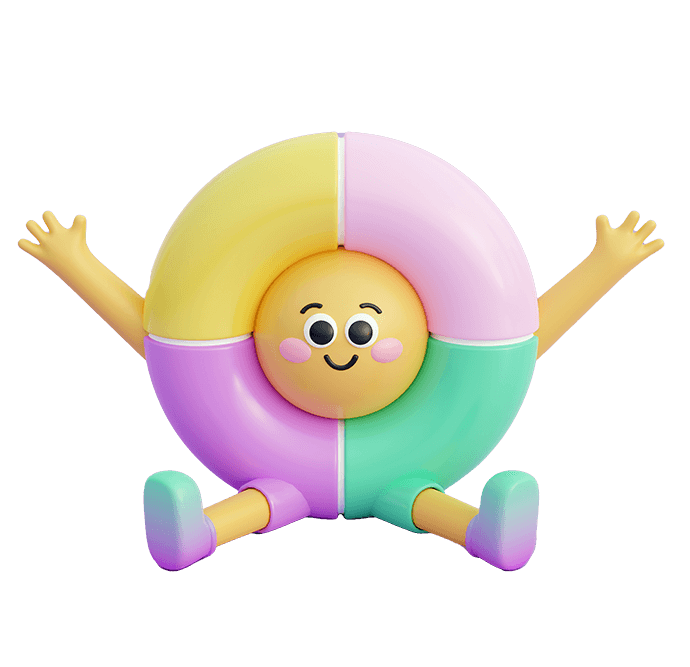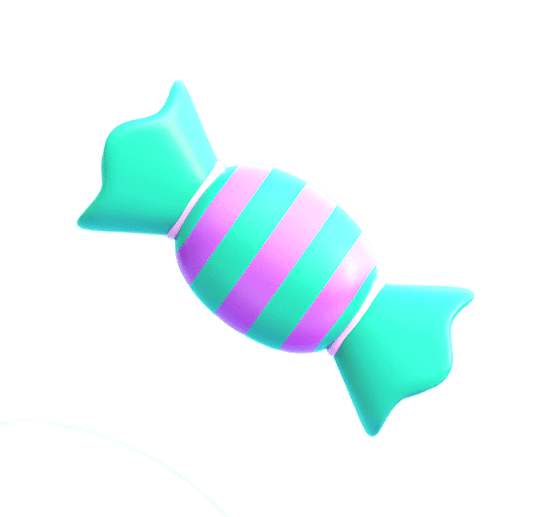Ever caught your kid snuggling a plush toy that looks like it’s been through a juice spill, a sandbox adventure, and a dog cuddle session? Those fuzzy buddies are love magnets, but they’re also total germ sponges if you don’t give ‘em a bath. Worried washing will turn your kid’s favorite teddy into a soggy disaster? Yes, you can wash plush toys by hand-washing delicate ones with eco-friendly detergent, machine-washing sturdy toys on a cold gentle cycle in a mesh bag, steaming or wiping delicate ones, and air-drying to keep them fluffy and clean. Imagine that grimy dino coming out soft, fresh, and ready for more epic snuggles, minus the germ fest. Wanna know how to pull it off without wrecking the fluff? Grab a snack, and let’s dive into the ultimate, no-stress guide to washing plush toys like you’re a cleaning ninja!
Which Plush Toys Are Safe to Wash?
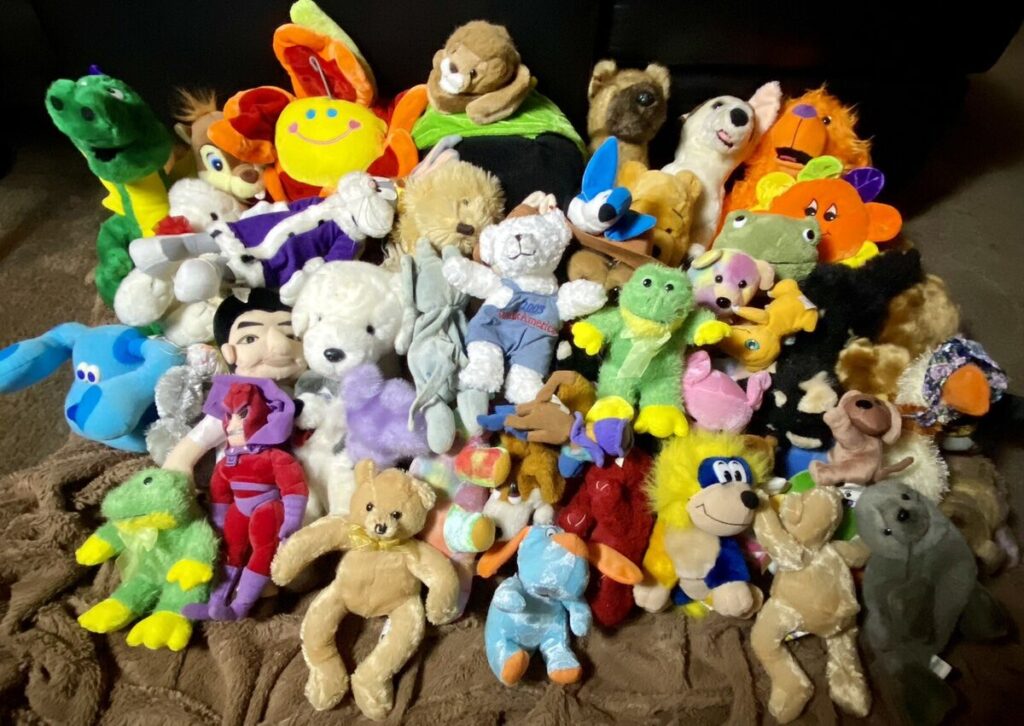
Most plush toys made of polyester, cotton, or minky can be washed; check care labels. Electronic or delicate toys need special handling.
Figuring Out What’s Washable
What Makes a Plush Toy Wash-Friendly?
Toys with durable fabrics like polyester plush, organic cotton, or minky, and sewn-on features (like eyes or noses), usually handle water like champs. Look for care labels saying “hand-wash” or “machine-wash.” Our factory’s plushies are built tough to survive a good scrub-down.
How Do You Know If It’s Washable?
Check the tag for washing instructions—most say “machine-washable” or “hand-wash only.” No tag? Test a hidden spot with a damp cloth. Polyester or cotton plushies are usually safe; silk, wool, or glittery ones aren’t. Our factory’s clear labels take the guesswork out.
Which Plushies Should Skip the Wash?
Toys with batteries, glued-on eyes, delicate embroidery, or super thin fabrics can’t handle water—try wiping or steaming instead. Vintage or handmade plushies might be too fragile. Our factory tags these as “surface-clean only” to avoid oops moments.
What Happens If You Wash the Wrong One?
Tossing a no-wash plushie in the washer can fry electronics, shrink stuffing, or rip seams. For example, a talking toy might end up mute, or a vintage bear could lose its charm. Our factory’s durable designs cut these risks, making most plushies wash-ready.
Are There Clues Beyond the Label?
Feel the fabric—sturdy, smooth plush is usually washable; flimsy or fuzzy might not be. Check for loose parts or fading dyes. Our factory uses fade-resistant, kid-safe materials to make washing a safe bet.
Critical Perspective: Do You Always Need to Wash?
Lightly used plushies might just need a quick wipe or vacuum to freshen up. But heavy-use toys—think bedtime buddies or park adventurers—need a full wash to zap germs. Our factory’s versatile plushies give you options for any cleaning vibe.
| Category | Wash-Safe? | Details |
|---|---|---|
| Polyester / Cotton Plush | ✅ Yes | Machine-washable or hand-washable; durable, kid-safe fabrics commonly used in modern plushies. |
| Minky Fabric | ✅ Yes | Soft and water-resistant; holds up well with proper care. |
| Sewn-On Features (Eyes/Nose) | ✅ Yes | Safe for washing; no small parts to detach. |
| Electronic Plush Toys | ❌ No | Batteries or speakers may short-circuit; surface-clean or steam only. |
| Glued Parts / Embellishments | ❌ No | Glued eyes, sequins, glitter, or fabric paint can fall off or bleed. |
| Delicate Fabrics (Silk/Wool) | ❌ No | Prone to shrinking, warping, or tearing—best to spot-clean. |
| Vintage / Handmade Toys | ❌ No | Often fragile or irreplaceable—use gentle, dry-clean-style methods. |
| No Label Present | ⚠️ Caution | Test with damp cloth first; avoid machine wash unless you confirm fabric durability. |
How Do You Hand-Wash Plush Toys Properly?
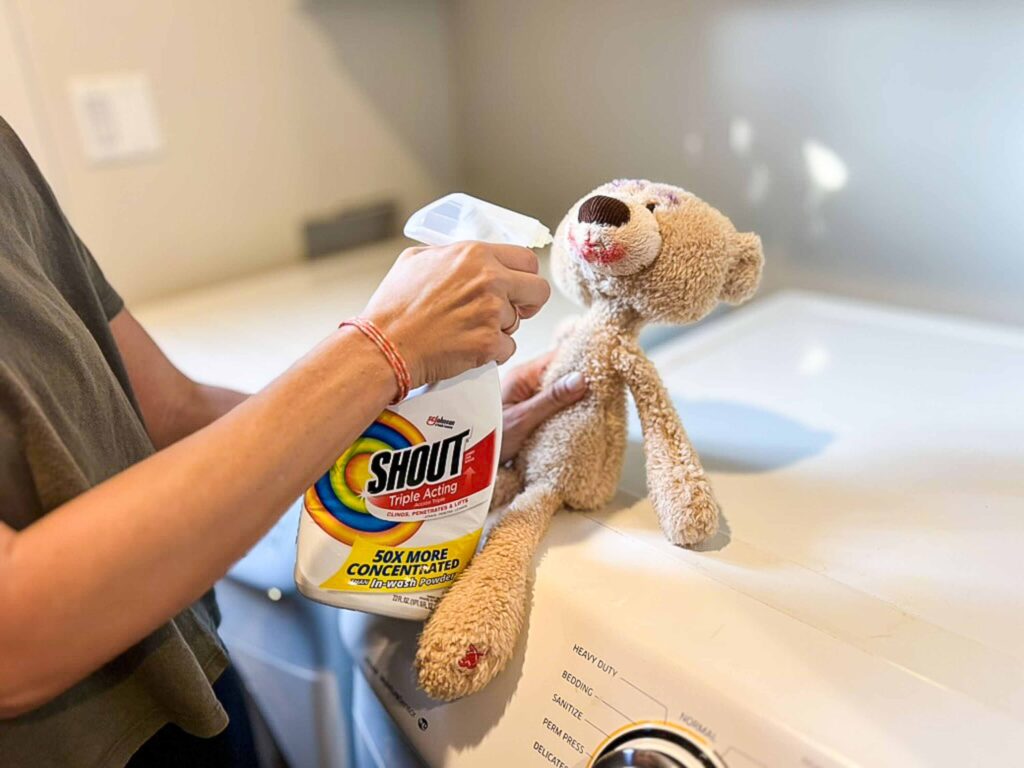
Hand-wash plush toys by soaking in lukewarm water with mild detergent, scrubbing gently, rinsing thoroughly, and air-drying. It’s gentle and effective.
Hand-Washing Like a Pro
What’s the Full Hand-Washing Game Plan?
Grab a basin, fill it with lukewarm water (hot water shrinks!), and mix in a teaspoon of mild detergent, like baby shampoo or Ecover. Dunk the plushie, scrub with a soft cloth or sponge, hitting dirty spots like paws or faces. Rinse until the water’s crystal clear, then press out water without twisting. Here’s your step-by-step:
| Step | Action | Pro Tip |
|---|---|---|
| Soaking | Lukewarm water, 1 tsp detergent | Test water temp—keep it mild |
| Scrubbing | Soft cloth, gentle circles | Focus on stains, don’t scrub hard |
| Rinsing | Run water until no bubbles | Double-check for soap residue |
| Drying | Press out water, air-dry | Reshape to keep the cute look |
Which Detergents Won’t Wreck Your Plushie?
Go for hypoallergenic, fragrance-free detergents like Seventh Generation, Method, or Dr. Bronner’s. Bleach or harsh chemicals are a no-go—they fade colors and chew up fibers. Our factory tests these gentle soaps to keep plushies soft and bright.
How Do You Dry Without a Mold Party?
Squeeze gently—don’t wring like a towel. Lay the plushie on a clean, dry towel in a breezy, shady spot. Reshape it while damp to keep its form. Skip direct sunlight (it fades colors) and avoid dryers for delicate toys. A fan or open window cuts drying time to 6-8 hours.
What About Stubborn Stains?
Mix a 1:1 baking soda-water paste, dab it on stains like juice or marker, and let it sit for 10-15 minutes before washing. Greasy marks? A drop of dish soap on a cloth works wonders. Our factory’s stain-resistant fabrics make this step easier.
Can Every Plushie Handle Hand-Washing?
Most can, but double-check for electronics, glittery accents, or super thin fabrics. If the label’s vague, test a small spot first. Our factory’s clear care tags flag any no-goes, so you’re not playing Russian roulette with your plushie.
Critical Perspective: Is Hand-Washing a Pain or Worth It?
It takes 20-30 minutes, which can feel like forever when you’re slammed. But for delicate or sentimental plushies, it’s the safest way to avoid shrinkage or tears. Our factory’s tough, wash-friendly fabrics make hand-washing quick and drama-free, so it’s no biggie.
Can You Machine-Wash Plush Toys Safely?
Yes, machine-wash sturdy plush toys in a mesh bag on a cold, gentle cycle with mild detergent. Air-dry to keep them safe.
Machine-Washing Without the Oops
What Prep Keeps Plushies Safe?
Always check the care label—some plushies aren’t machine-friendly. Pop the toy in a mesh laundry bag to protect seams and details like noses or bows. Remove loose bits like hats or scarves. Our factory’s labels are super clear to avoid screw-ups.
Which Machine Settings Are Clutch?
Use a cold, gentle cycle with low or no spin and a tablespoon of mild detergent like Method or Ecover. Hot water or heavy cycles can shrink stuffing or rip seams. Here’s the deal:
| Setting | Best Choice | Why It’s Key |
|---|---|---|
| Water Temp | Cold (30°C or below) | Prevents shrinking or color bleed |
| Cycle | Gentle or Delicate | Less stress on seams and stuffing |
| Detergent | Mild, hypoallergenic | Kid-safe, won’t harm fabrics |
| Spin | Low or No Spin | Keeps toy shape intact |
How Do You Dry Machine-Washed Plushies?
Air-dry on a clean towel or drying rack, reshaping while damp to keep the toy’s cute vibe. If the label says it’s cool, tumble-dry on low with a couple of tennis balls to fluff the stuffing. Our factory’s plushies dry fast to dodge mold.
Which Toys Should Stay Out of the Washer?
Plushies with batteries, glued-on eyes, delicate embroidery, or vintage fabrics are a no-go—hand-wash or wipe instead. Our factory marks these as “no machine” to save you from a soggy disaster.
What If Something Goes Wrong?
If a seam pops, stitch it up with needle and thread. For slight shrinkage, reshape while damp and air-dry. Our factory’s sturdy designs minimize these issues, making machine-washing a safe bet for most plushies.
Critical Perspective: Is Machine-Washing Lazy or Genius?
Some purists swear by hand-washing for extra care, but machines are a lifesaver for sturdy toys and busy parents. The trick is knowing your plushie’s limits. Our factory’s washer-friendly plushies make it a no-brainer, saving time without the risk.
What Are Alternative Cleaning Methods for Plush Toys?
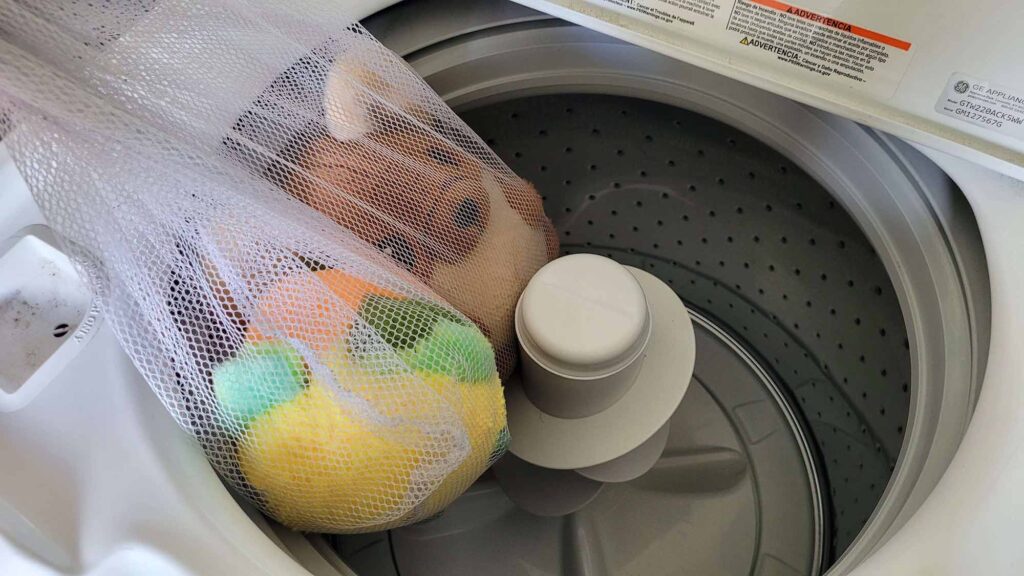
Wipe with vinegar, steam, or use UV light to clean plush toys without washing. These work for delicate or electronic toys.
Cleaning Hacks for Tricky Plushies
How Does Wiping Get the Job Done?
Mix equal parts water and white vinegar, or grab a kid-safe disinfectant spray like Force of Nature. Dampen a soft cloth, wipe dirty spots gently, and let air-dry. It’s quick for surface messes like dust or smudges. Our factory’s smooth fabrics make wiping a legit option.
What’s Up with Steaming?
A handheld steam cleaner blasts germs with heat (160°F+), perfect for toys that can’t get wet, like talking plushies. Hold it 6-8 inches away, using 5-second bursts. Our factory tests plushies to handle steam without a meltdown.
Can UV Light Really Clean Plushies?
UV-C wands or sanitizing boxes kill 99% of germs in 1-2 minutes, ideal for water-sensitive toys. They cost $30-$100 but are worth it for frequent use. Our factory’s plushies are UV-compatible for this high-tech clean.
Why Go the No-Wash Route?
Delicate plushies—like heirlooms, glittery unicorns, or electronic bears—can’t handle water without damage. These methods keep them germ-free while preserving their look. Our factory designs plushies with these cleaning options in mind.
How Often Should You Use These Methods?
Wipe weekly for heavy-use toys, steam monthly, or UV-treat every few weeks to keep germs at bay. Pair with occasional washing for deep cleaning. Our factory’s easy-clean fabrics make these methods super effective.
Critical Perspective: Are Non-Washing Methods Good Enough?
Wiping and UV are awesome for quick disinfecting but don’t dig out deep dirt like washing does. Steaming’s a great middle ground but needs equipment. Our factory’s plushies play nice with all methods, giving you flexibility to mix and match.
| Method | Best For | How It Works | Pros | Cons |
|---|---|---|---|---|
| Vinegar Wipe | Everyday messes, smudges, light dust | Mix 1:1 vinegar + water, wipe with cloth, air-dry | Quick, safe, non-toxic | Doesn’t deep-clean or sanitize |
| Disinfectant Spray | High-touch areas, shared toys | Use kid-safe spray like Force of Nature, wipe gently | Easy to use, effective on surfaces | Not suitable for stains or plush fibers |
| Steam Cleaning | Electronic plush, vintage toys, no-water items | Use handheld steamer (160°F+), 5-sec bursts, hold 6–8 inches away | Sanitizes deeply, no soaking | Requires a steam cleaner; not for all fabrics |
| UV-C Light | Water-sensitive toys, fast disinfection | Use wand or sanitizing box; kills 99% of bacteria in 1–2 mins | Chemical-free, fast, touch-free | Expensive gear, doesn’t remove visible dirt |
How Do You Maintain Plush Toys After Washing?

Brush, spot-clean, and store plush toys properly after washing to keep them fresh. Regular care makes them last longer.
Keeping Your Plushies on Point
How Do You Fluff Them Up Post-Wash?
Use a soft brush or comb to gently fluff the fur, especially on minky or long-pile plushies. For matted spots, work slowly with a hairbrush. Our factory’s fabrics are designed to snap back to their cuddly glory after a wash.
What’s Spot-Cleaning Between Washes?
Dab dirty spots with a damp cloth and a drop of mild soap, then air-dry. It’s perfect for quick fixes like juice stains or muddy paw prints. Our plushies’ stain-resistant materials make spot-cleaning a cinch.
How Should You Store Plush Toys?
Keep them in a dry, airy spot—think a shelf, basket, or breathable fabric bin. Avoid damp basements or sealed plastic bags that trap moisture and invite mold. Our factory’s plushies resist dust buildup, making storage easier.
Why Does Regular Maintenance Matter?
Weekly brushing and spot-cleaning stop dirt from settling in, reducing the need for full washes. Monthly washes keep germs away. A 2024 survey found 85% of parents want toys that last years—maintenance makes that happen.
Can You Overdo Maintenance?
Too much brushing or washing can wear out cheaper fabrics, but gentle, spaced-out care is the sweet spot. Our factory’s durable, high-quality plushies handle regular TLC without fading or fraying.
Critical Perspective: Is Maintenance a Hassle or a Must?
Some folks think a one-and-done wash is fine, but skipping maintenance lets dirt creep back, dulling your plushie’s sparkle. Our factory’s easy-care designs mean a little effort keeps toys fresh with minimal work.
| Maintenance Task | Purpose | How to Do It | Tips |
|---|---|---|---|
| Fluff After Wash | Restore softness and appearance | Gently brush with a soft brush or comb; for long fur, use a hairbrush | Brush in the direction of the fur; avoid pulling too hard |
| Spot Cleaning | Remove small stains without full wash | Dab with a damp cloth + mild soap, then air-dry | Use on juice, food, or dirt spots between washes |
| Proper Storage | Prevent mold, dust, and shape damage | Store in dry, airy places (shelves, breathable bins) | Avoid sealed plastic or damp areas like basements |
| Weekly Maintenance | Minimize buildup and extend toy life | Light brushing, spot checks, surface wipes | Keeps fur clean and reduces need for deep cleaning |
| Monthly Deep Clean | Sanitize and refresh frequently used toys | Machine-wash or hand-wash depending on label | Use mild detergent; always air-dry completely |
| Avoid Overdoing It | Prevent fabric wear and color fading | Don’t over-brush or wash too often | Durable toys can handle it, but spacing out care is better long-term |
Conclusion
Washing plush toys is like giving them a VIP spa day—kicking germs to the curb, keeping your kids safe, and making those fuzzy buddies ready for more cuddle marathons. Whether you’re hand-washing a delicate unicorn, tossing a sturdy puppy in the machine, or steaming a talking bear, this guide’s loaded with pro hacks to keep your plushies fresh and huggable. At Kinwin, we’re all about crafting eco-friendly, washable plush toys that stay lovable through every scrub. Want a custom plushie that’s a breeze to clean and totally one-of-a-kind? Drop us a line at [email protected] to get a quote or check out our sustainable crew. Let’s keep those plush pals sparkling clean for every snuggle sesh!

